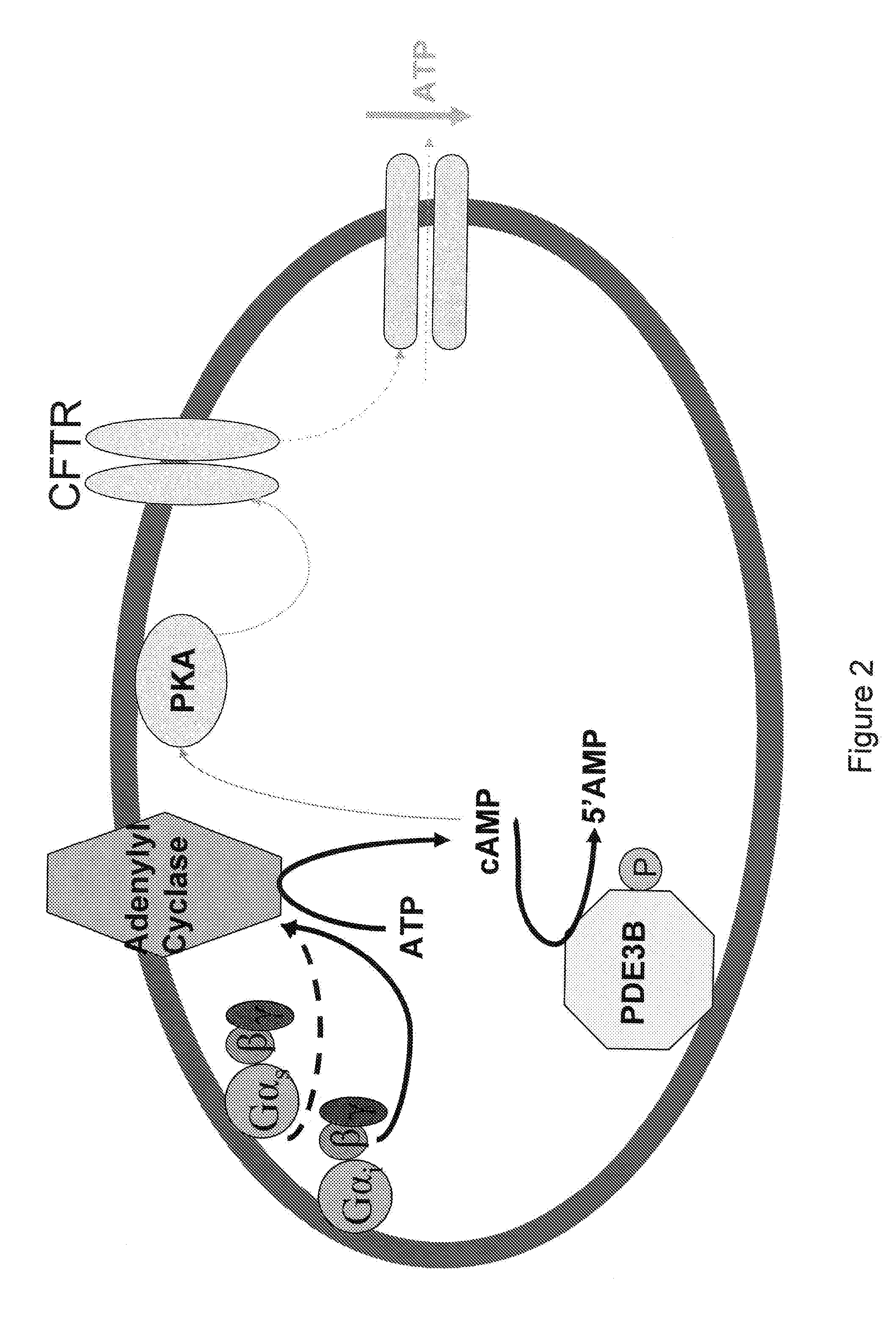Method of screening for a drug candidate that increases ATP release from RBCs stimulated via the Gs or Gi pathway
a technology of rbcs and atp release, which is applied in the direction of elcosanoid active ingredients, instruments, metabolic disorders, etc., can solve the problems that the role of insulin in rbc activity has not been elucidated, and achieve the effect of increasing atp production or releas
- Summary
- Abstract
- Description
- Claims
- Application Information
AI Technical Summary
Benefits of technology
Problems solved by technology
Method used
Image
Examples
example 1
PDE3 in RBCs and the Effect of Insulin on ATP Release by RBCs
[0162]Erythrocytes possess the heterotrimeric G proteins Gi and Gs as well as adenylyl cyclase. Importantly, activation of either of these G proteins results in stimulation of adenylyl cyclase and the synthesis of cAMP. Increases in cAMP are required for ATP release from erythrocytes. ATP released from erythrocytes in the vascular lumen is a stimulus for nitric oxide synthesis. Incubation of erythrocytes with Mastoparan 7, a compound that activates Gi, results in increases in cAMP and ATP release (Am. J. Physiol. Heart Circ. Physiol. 287(2): H748-H754, 2004, which is herein incorporated by reference.) The concentration of cAMP in cells is dependent on the rate of its synthesis as well as its degradation by phosphodiesterases (PDEs). Previous studies demonstrate that PDE3 activity is increased by insulin and inhibited by cilostazol in a number of cell types (Cell. Signal. 7(5): 445-455, 1995). Erythrocytes have a well chara...
example 2
[0169]Insulin decreases cAMP accumulation in human erythrocytes and, consequently, attenuates ATP release in response to exposure to reduced O2 tension as well as pharmacological activation of the heterotrimeric G proteins Gs and Gi. Incubation of erythrocytes of humans with mastoparan 7 (MAS7), a direct activator of Gi, results in cAMP accumulation and ATP release [10, 12]. In other cells, insulin has been has been shown to decrease cAMP levels, a requisite for erythrocyte ATP release, by activating phosphodiesterase 3 (PDE3) [20, 23].
[0170]The inventors have shown that pre-incubation of human erythrocytes with insulin (1 μM) attenuated MAS7 (10 μM)-induced ATP release in the absence of changes in total ATP content (FIG. 9, Example 1). Importantly, insulin pre-treatment also resulted in inhibition of MAS7 (10 μM)-induced cAMP accumulation (FIG. 8, Example 1). These results provide support for the hypothesis that insulin, at concentrations present in humans with pre-diabetes, inhibi...
example 3
[0176]Insulin-induced inhibition of erythrocyte cAMP accumulation and ATP release is mediated via activation of the insulin receptor resulting in the stimulation of a signaling pathway reasonably expected to involve PI3K / PKB and, ultimately, activation of PDE3. Although human erythrocytes have been shown to possess insulin receptors [25, 26, 46, 47], a role in erythrocyte physiology has not been defined. The preliminary results reported above (FIGS. 8, 9) suggest that insulin can inhibit both cAMP accumulation and ATP release from erythrocytes. Importantly, the effect on cAMP accumulation is greater at lower (nM) insulin concentrations (FIG. 8). The latter finding is consistent with the hypothesis that this effect of insulin is receptor mediated. The binding of insulin to its receptor displays negative cooperativity, such that the dissociation rate of insulin accelerates with increased receptor occupancy [55, 56]. The result is that lower concentrations of insulin stimulate a greate...
PUM
| Property | Measurement | Unit |
|---|---|---|
| pH | aaaaa | aaaaa |
| pH | aaaaa | aaaaa |
| wavelength | aaaaa | aaaaa |
Abstract
Description
Claims
Application Information
 Login to View More
Login to View More - R&D
- Intellectual Property
- Life Sciences
- Materials
- Tech Scout
- Unparalleled Data Quality
- Higher Quality Content
- 60% Fewer Hallucinations
Browse by: Latest US Patents, China's latest patents, Technical Efficacy Thesaurus, Application Domain, Technology Topic, Popular Technical Reports.
© 2025 PatSnap. All rights reserved.Legal|Privacy policy|Modern Slavery Act Transparency Statement|Sitemap|About US| Contact US: help@patsnap.com



